Highlights from the GDST/MSP Mini-Conference
On 15 March, the AIAA Gravity Dependent Science and Technology Technical Committee (GDST-TC), formerly known as the Microgravity Space Processes Technical Committee (MSP-TC), hosted a mini-conference in collaboration with the AIAA Los Angeles Section.
The conference was organized in response to NASA’s release of the LEO Microgravity Strategies in December 2024, which align efforts in low Earth orbit microgravity research—including ISS programs—with broader goals for future cislunar, lunar, and Mars missions aimed at enabling safe, long-duration human spaceflight. This topic closely aligns with the mission of the AIAA GDST-TC, which has long supported the advancement of gravity-dependent science and technology—across hypo- and hyper-gravity environments—in the physical, materials, and biological sciences, as well as their applications in industry and space manufacturing.
In-person and virtual speakers, panelists, and attendees engaged in dynamic discussions reflecting the momentum sparked by NASA’s recent announcement of the LEO Microgravity Strategy, which builds on decades of ISS and low Earth orbit microgravity research to support the development of safe, long-duration human missions to the moon and Mars.
The opening briefing, given by Adrian Radocea, chief science officer at Varda Space Industries, focused on Varda’s recently Mach 25+ space capsule for hypersonic microgravity bio-pharmaceutical experiment. David Caponio, senior vice president of Product and Business Development, VAST Space, gave us insight into Vast’s Haven-1 and expanding opportunities in LEO. Industry professionals also discussed the current research and development.
Interested in joining or participating with AIAA GDST-TC? Please reach out via www.linkedin.com/company/aiaa-msptc.




